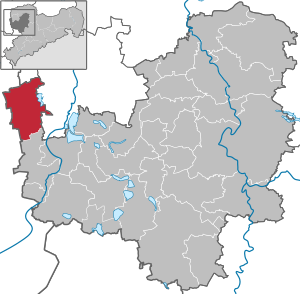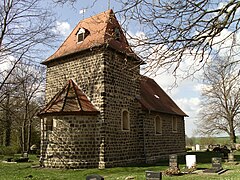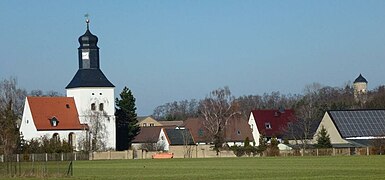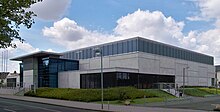Markranstädt
| coat of arms | Germany map | |
|---|---|---|

|
Coordinates: 51 ° 18 ' N , 12 ° 13' E |
|
| Basic data | ||
| State : | Saxony | |
| County : | Leipzig | |
| Height : | 119 m above sea level NHN | |
| Area : | 58.46 km 2 | |
| Residents: | 15,781 (Dec. 31, 2019) | |
| Population density : | 270 inhabitants per km 2 | |
| Postal code : | 04420 | |
| Primaries : | 034205, 0341, 034444 | |
| License plate : | L , BNA, GHA, GRM, MTL, WUR | |
| Community key : | 14 7 29 270 | |
| City structure: | 17 districts | |
City administration address : |
Markt 1 04420 Markranstädt |
|
| Website : | ||
| Mayor : | Jens-Reiner Spiske (independent) | |
| Location of the city of Markranstädt in the district of Leipzig | ||
Markranstädt [emphasis on the first syllable] is a small town in the Leipzig district in Saxony .
Geography and location
Markranstädt is located in the Leipzig lowland bay about ten kilometers southwest of the center of Leipzig . The city borders in the north on Schkeuditz , in the east on Leipzig, in the south on Pegau and in the west on the cities of Lützen , Bad Dürrenberg and Leuna in Saxony-Anhalt . It is located on the west bank of the Kulkwitzer See .
Districts
Local division
In addition to the actual urban area, Markranstädt consists of 17 districts in six localities:
| Locality | Districts |
|---|---|
| Frankenheim | Frankenheim, Lindennaundorf, Priesteblich |
| Goehrenz | Albersdorf, Goehrenz |
| Großlehna | Altranstädt , Großlehna, Kleinlehna |
| Kulkwitz | Gärnitz, Kulkwitz, Seebenisch |
| Markranstädt | Markranstädt |
| Quesitz | Döhlen, Quesitz, Thronitz |
| Räpitz | Meyhen, Räpitz, Schkeitbar, Schkölen |
Incorporations
| Former parish |
date | annotation |
|---|---|---|
| Albersdorf | July 1, 1950 | Incorporation to Göhrenz |
| Altranstädt | July 1, 1950 | Incorporation to Großlehna |
| Döhlen | July 1, 1950 | Incorporation after Thronitz |
| Frankenheim | January 1, 1997 | Incorporation to Markranstädt |
| Gärnitz | April 1, 1936 | Incorporation to Kulkwitz |
| Goehrenz | March 1, 1994 | Incorporation to Markranstädt |
| Großlehna | January 1, 2006 | Incorporation to Markranstädt |
| Kleinlehna | October 1, 1939 | Incorporation to Großlehna |
| Kulkwitz | January 1, 1999 | Incorporation to Markranstädt |
| Lindennaundorf | July 1, 1950 | Incorporation to Frankenheim |
| Meyhen | July 1, 1950 | Incorporation to Räpitz |
| Priestly | June 1, 1973 | Incorporation to Dölzig |
| 1994 | Incorporation to Bienitz | |
| January 1, 2000 | Reclassification to Markranstädt | |
| Quesitz | January 1, 1994 | Incorporation to Markranstädt |
| Räpitz | January 1, 1994 | Incorporation to Markranstädt |
| Schkeitbar | July 1, 1950 | Incorporation to Räpitz |
| Schkölen | July 1, 1950 | Incorporation to Räpitz |
| Seebenisch | July 1, 1948 | Incorporation to Kulkwitz |
| Thronitz | June 1, 1973 | Incorporation to Quesitz |
history
Markranstadt was first mentioned in a document in 1285 as a court seat. Presumably a subsidiary of the neighboring Altranstädt monastery, it is mentioned in 1287 as a market town and in 1354 as a town. The name is also derived from the founding: As Ranstädt ( ran = "place on cleared ground"), while at the same time Ranstädt became Altranstädt. Ranstädt then got the market rights, from which the current name Markranstädt is derived. A document from 1285 proves the sale of the court seat Ranstete (Markranstädt) with 29 villages from the Margrave of Landsberg to the Bishop of Merseburg. In the period that followed, Markranstädt belonged to the Hochstift-Merseburg office of Lützen until 1815 , which had been under Electoral Saxon sovereignty from 1561 and belonged to the secondary school principality of Saxony-Merseburg between 1656/57 and 1738 .
In 1633, during the Thirty Years' War , the town was burned down by the Holk riders . Among other things, the town hall with all its writings fell victim to the fire. The plague epidemic in 1634 and the famine of 1639 led to a drastic population decline. In 1650 Markranstädt had fewer than 150 inhabitants. The next local catastrophe occurred in 1671, when 31 houses were destroyed in a large fire. The city only recovered at the beginning of the 18th century. Altranstädt Palace was the political center of Northern Europe from 1706 to 1707 when the Swedish king took his headquarters there.
His second point of contact with the world's history had Markranstädt on 23 July 1807, when Napoleon Bonaparte spent the night together wake for the first time at the inn "To the Rosary", and on 19 October 1813, when Napoleon on his return after the Battle of Leipzig on the way from Lindenau to Lützen again in the inn "Zum Rosenkranz". In the course of the Battle of the Nations near Leipzig, the city was again badly affected in 1813. Through the resolutions of the Congress of Vienna , the western part of the Lützen office and the Altranstädt exclave belonging to the Leipzig district office were ceded to Prussia in 1815. However, Markranstädt remained with the eastern part of the Lützen office in the Kingdom of Saxony and was incorporated into the Leipzig district office. It was now on the border with Prussia. From 1856 Markranstädt was the main town of the Markranstädt court office and from 1875 the town belonged to the Leipzig District Administration .
Markranstädt experienced an economic boom towards the end of the 19th century. Due to the proximity to the fur trade center of the Leipziger Brühl , mainly the fur dressing , the fur finishing and the furrier trade flourished . Then there was the mechanical engineering, the Markranstädter automobile factory , but above all the Markranstädter brewery. Until the Second World War it was widely known for its “Markranstädter Pilsener”. The first hospital was opened in 1886, and the waterworks and gas station, the water tower and the associated pipes were built in 1895.
At the beginning of the Nazi era , opponents of the Nazi regime were persecuted and imprisoned. On March 11, 1933, the communist Oswald Jäckel was murdered by SA men . In his memory, an old people's home and today's Krakauer Strasse bore his name in the GDR era.
In 1947 the city hospital was opened in Marienstrasse, which later served as the gynecological department. The hospital was closed in 1993, so that since then the residents have had to go to the deaconess hospital in Leipzig , for example, which is about 10 km away .
Incorporations
Frankenheim and Lindennaundorf were incorporated on January 1, 1997. On January 1, 1999, the districts of Gärnitz, Kulkwitz and Seebenisch with at that time 1,091 inhabitants on 5.98 km² were incorporated into the city by the dissolved municipality of Kulkwitz. On January 1, 2000, the Priesteblich district followed from the dissolved municipality of Bienitz . On January 1, 2006, Großlehna was added.
Lindennaundorf, on the right the Rückmarsdorfer water tower
politics
City council
Since the municipal council election on May 26, 2019 , the 22 seats of the city council have been distributed among the individual groups as follows:
- CDU : 10 seats
- AfD : 4 seats
- LEFT : 2 seats
- SPD : 2 seats
- Free voters Markranstädt e. V. (FWM): 2 seats
- Greens : 1 seat
- Citizens for Markranstädt (BfM): 1 seat
mayor
On September 30, 2012, the former Bundeswehr doctor Jens-Reiner Spiske (FWM eV) was elected Mayor of the city of Markranstädt with 51.6% of the vote. Incumbent Carina Radon (CDU) received 48.4%. He was unable to take up office for over a year due to an election challenge (lawsuit). With the decision of the Higher Administrative Court of Bautzen on November 7, 2013, the election contestation was irrevocably dismissed. Jens-Reiner Spiske took office on November 21, 2013, and was sworn in publicly during the 45th city council meeting on December 5, 2013. Spiske is the first non-party mayor in Markranstadt's recent history.
badges and flags
The coat of arms shows a saint nimbly in gold on green ground in a red robe and blue cloak, in his right hand he holds a silver knife with the blade pointing upwards, over his left forearm he has a fabric-like object. Saint Bartholomew , the patron saint of the city, is depicted with his slicer knife and the skin peeled off from him.
The city colors are yellow - green, arranged one below the other.
Twin town
Culture
With the town hall built in 1999, the city has a building in which a variety of events can take place.
Markranstädt is also popularly called Lallendorf. This is even in the motto of the Markranstädter Carneval Club e. V. flowed in (Lallendorf -oho-, Markranstädt -oho-, MCC -oho-).
Since the year 2000 there has been an annual Markranstädter Musiksommer in the town church of St. Laurentius, which has become a fixture in the town of Markranstädt and beyond. In addition to regional “young musicians”, internationally known artists also performed. The jazz musicians David Timm and Reiko Brockelt also provided variety in the program . The opening and closing concerts with the orchestra of the Sinfonisches Musikverein Leipzig e. V., which consists of professional musicians as well as lay people.
The Markranstädt high school offers 5th and 6th grade students the opportunity to learn a wind instrument of their choice or drums as part of their music lessons and even to play at concerts with their classmates. Students who want to continue playing after these two years can join the cross-class Youth Brass Orchestra .
Attractions
- see also: List of cultural monuments in Markranstädt
- Kulkwitzer See with 160 hectares of water and 200 hectares of shore zone, which is particularly popular with water sports enthusiasts, holidaymakers and hikers
- St. Laurentius City Church, built 1518–1525, reconstruction and heightening of the church tower 1899–1900 by Julius Zeißig
- Romanesque churches in Kulkwitz and Frankenheim (tower from 1513)
- Baroque churches in Schkeitbar and Quesitz (built in 1757, organ destroyed during the Battle of Nations, new organ in 1819, new bells in 2010)
- Catholic Church Maria Hilfe der Christians in Markranstädt, built in 1896
- Altranstädter castle with church, rectory and chapel of the Counts of Hohenthal-Dölkau
- Functional post mill in the Lindennaundorf district
- Tree house after-school care center in Markranstädt and elementary school in Großlehna from the 21st century (Markurt Architekturkontor from Leipzig)
- Sculpture Anima Urbana by Christian Schmit in the city park
- Post mill Frankenheim-Lindennaundorf
Memorials
- Oswald Jäckel's urn is buried at the memorial for the victims of fascism in the cemetery .
- At the grave site for Soviet prisoners of war who were victims of forced labor during the Second World War , a plaque commemorates six victims known by name and one unknown.
- The graves and a memorial stone for two unknown people, presumably from the Soviet Union, who were abducted to Germany during the Second World War and were victims of forced labor, are located in the cemetery in the Kulkwitz district .
- In the cemetery of the Räpitz district , graves commemorate two Soviet women known by name who were deported to Germany and were victims of forced labor.
- Under the so-called Peace Oak of the Frankenheim district there is a memorial stone to commemorate the fallen Frankenheimers and all victims of war and violence.
- Stumbling blocks, for example on Leipziger Strasse. In memory of the victims of National Socialism.
Sports
Markranstädt describes itself as a "sports city"; the sports center, which was newly opened in 2007, is the largest ball sports hall in the Leipzig district.
In addition to a large swimming pool, the outdoor pool offers a separate non-swimmer area, a children's pool, diving platforms and beach volleyball courts.
The women's handball team of SC Markranstädt played successfully in the 2nd Bundesliga for 9 years . The men of the volleyball club VC Markranstädt reached the quarter-finals in the 1st Bundesliga in 2006. In the same year the association merged with VV Leipzig to VC Leipzig .
In SSV Markranstädt , founded in 1990, most of the sections of the predecessor of the large-scale sports club BSG Turbine went up. Since 2011 the SSV has been a pure football club with around 300 members in 16 teams. The first men's team was transferred to the beverage company Red Bull for the 2009/10 season , the new first men's team will play in the sixth class Saxony league in the 2018/19 season .
The Markranstädt Canoe & Leisure Club offers children and young people the opportunity to exercise.
Economy and Infrastructure
traffic
Road traffic
Markranstädt has very good transport links to the city of Leipzig. The city has two connections to the A 9 and two connections to the A 38 . The federal highways 87 and 186 intersect in the urban area . In addition, Leipzig-Halle Airport (twelve kilometers away) can be easily reached via the A 9 or the federal highways.
Rail transport
Markranstädt is on the Leipzig – Großkorbetha –Erfurt railway and was connected to the railway network from March 22, 1856 with the opening of the Corbetha – Leipzig section.
The station is the traffic stop of the hourly line RB20 to Leipzig, Naumburg, Erfurt and Eisenach. Since December 2015 there is a customer center at the train station in Markranstädt, which is operated by Abellio Rail Mitteldeutschland .
The Großlehna stop is also served in the urban area .
Local transport
Through LeoBus GmbH , a subsidiary of the LVB Group , Markranstädt is connected to the city of Leipzig, the Cospudener See and the city of Markkleeberg via the 65 bus . In addition, the lines 61, 121, 130, 161, 163 and 165 run to Leipzig and Lützen , the districts of the city of Markranstädt and the Nova shopping center . The Merseburg-Querfurt local passenger transport company (PNVG) connects Markranstädt with line 743 in the direction of Bad Dürrenberg and Merseburg .
In night traffic , the city is served by the Nightliner N2 (Leipzig Hbf. - Markranstädt).
The city is part of the Central German Transport Association ; Markranstädt and its districts belong to tariff zone 156.
Established businesses
In the center there are numerous retail stores, especially along Leipziger Strasse. The industrial areas Kulkwitz, Großlehna, Frankenheim and Ranstädter Mark also make Markranstädt interesting for larger industrial and commercial enterprises.
schools
Markranstädt has a high school and a grammar school with a linguistic, scientific and artistic profile. There is a primary school each in Markranstädt and in the districts of Kulkwitz and Großlehna.
Personalities
- Claus Narr (before 1486 - after 1530), well-known court jester
- Viktor Böhmert (1829–1918), journalist, free trader, economist and statistician
- Viktor Schumann (1841–1913), physicist who discovered vacuum ultraviolet radiation
- Karl Emil Kirchner (1845–1899), Saxon lieutenant general born on the Quesitz manor
- Max Kirmsse (1877–1946), teacher at the Kalmenhof , historian, politician
- Hugo Ruppe (1879–1949), founder of the Markranstädter automobile factory MAF
- Max Strötzel (1885–1945), politician (KPD)
- Kurt Schiering (1886–1918), painter and graphic artist
- Karl Hans Drechsel (1904–1946), Mayor (NSDAP)
- Heino Weiprecht (1912–1988), politician (SED) and State Secretary of the GDR
- Oskar-Hubert Dennhardt (1915–2014), general and CDU politician
- Rolf Kauka (1917–2000), comic book publisher
- Horst Kaminsky (1927–2019), politician (SED), President of the State Bank of the GDR
- Günter Hennig (* 1928), publishing director
- Rudi Glöckner (1929–1999), football referee
- Almut Brömmel (* 1935), track and field athlete and Olympic participant
- Dieter Fischer (1936–2016), football player
- Wolfram Löwe (* 1945), football player
- Bernd Trunzer (1947–2018), football player
- Wolfgang Altmann (* 1952), soccer player
- Jürgen Richter (* 1953), badminton player
literature
- Heinrich Engelbert Schwartze: Leipziger Land-Chronik (third part, 1st chapter: Von Marck-Rannstaedt ), PRO LEIPZIG - Verlag, Leipzig 2006, ISBN 3-936508-23-2 .
- Christa Berbig: Markranstädter Spätlese. Self-published, Schwerin 2007.
- Günther Kluge, Hanna Kämmer: Markranstädt: The city on the lake - history and stories. Geiger-Verlag, 2002, ISBN 3-89570-825-9 .
- Cornelius Gurlitt : Markranstädt. In: Descriptive representation of the older architectural and art monuments of the Kingdom of Saxony. 16. Issue: Amtshauptmannschaft Leipzig (Leipzig Land) . CC Meinhold, Dresden 1894, p. 84.
- Cornelius Gurlitt : Quesitz. In: Descriptive representation of the older architectural and art monuments of the Kingdom of Saxony. 16. Issue: Amtshauptmannschaft Leipzig (Leipzig Land) . CC Meinhold, Dresden 1894, p. 108.
- An extensive tradition of the city of Markranstädt for the period 1617–1962 on imperial, constitutional and community affairs, finances, military and war affairs, health and social affairs, trade, commerce, mining, industry, agriculture and forestry, fishing, regulatory affairs and security police, fire protection, statistics, elections, school, church, building management, guilds, associations, the city court and registry office is located in the Saxon State Archives, State Archives Leipzig, stock 20612 City Markranstädt.
Web links
- Official website of the city
- Markranstädt in the digital historical place directory of Saxony
Individual evidence
- ↑ Population of the Free State of Saxony by municipalities on December 31, 2019 ( help on this ).
- ↑ Duden online. Bibliographisches Institut GmbH, accessed on May 15, 2012 .
- ^ Website of the Heimatverein Frankenheim-Lindennaundorf
- ^ Karlheinz Blaschke , Uwe Ulrich Jäschke : Kursächsischer Ämteratlas , Leipzig 2009, ISBN 978-3-937386-14-0 , p. 84 f.
- ^ Vive L'Empereur - Napoleon in Leipzig. 1st edition. PRO Leipzig Verlag, Leipzig 2008, ISBN 978-3-936508-40-6 .
- ↑ The Amtshauptmannschaft Leipzig in the municipal register 1900
- ^ StBA: Changes in the municipalities, see 1997
- ↑ StBA: Changes in the municipalities in Germany, see 1999
- ↑ StBA: Changes in the municipalities in Germany, see 2006
- ↑ Results of the 2019 municipal council elections
- ↑ lvz.de
- ↑ markranstaedt.de
- ^ Markranstädt - The city on the lake. 1st edition. Geiger-Verlag, Horb am Neckar 2002, ISBN 3-89570-825-9 .
- ↑ 20612 City of Markranstädt. In: State Archives Leipzig. Retrieved March 27, 2020 . (Info text under "Introduction")




















